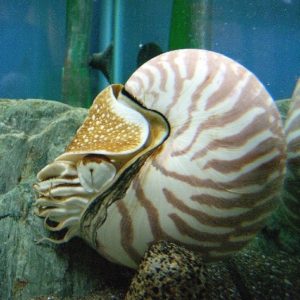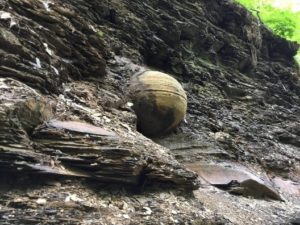By Casey Smith, Naturalist
The first time I visited Shale Hollow, I was amazed by all the huge round rocks I could see throughout the shale creek bed. I had never seen anything like these before. If you have visited Shale Hollow Park, you may have asked yourself, “What are those round rocks all over the place?” Being a geology nerd, I just had to know.
Let’s take a trip back in time to 400 million years ago. The land we call Ohio was south of the equator and covered by a shallow sea. Picture a coral reef with ancient sharks and nautilus swimming around in your back yard. When an organism died, it would fall to the bottom of the shallow sea. Since there was not a lot of oxygen here, it took a long time for the organism to decompose. Because of that, minerals could collect around the slowly decomposing organic matter. Over time, these minerals compacted and began to form the round rocks called concretions you see in many areas along the Olentangy River. The material in the center of a concretion is limestone, a sedimentary rock that contains many of Ohio’s fossils, and is commonly used in driveways, buildings, and even on Preservation Parks trails. The outside of a concretion is dolomite, a mineral that is rich in iron. Because of this, concretions are much heavier than rocks of similar size. Think of a Tootsie Pop – hard substance outside, softer material inside.
 So can you find fossils inside concretions? If you find yourself lucky enough to peer inside one of these giant round rocks, you may find a cool fossil, maybe an ancient nautilus like the one pictured. Photo credit I love that we can look at rocks and learn the history of the Earth. See if you can find my favorite concretion in the park, pictured here. It reminds me of the Death Star from Star Wars.
So can you find fossils inside concretions? If you find yourself lucky enough to peer inside one of these giant round rocks, you may find a cool fossil, maybe an ancient nautilus like the one pictured. Photo credit I love that we can look at rocks and learn the history of the Earth. See if you can find my favorite concretion in the park, pictured here. It reminds me of the Death Star from Star Wars.






